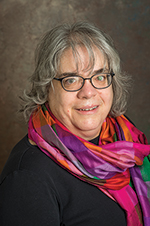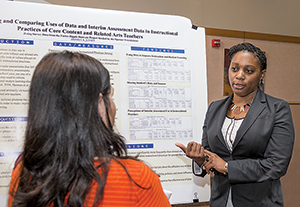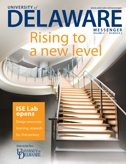Research briefs
Getting at the root of arsenic contamination in rice

Two scientists in the Department of Plant and Soil Sciences are studying a bacterium first characterized at UD to see if it could be used to create an iron shield around the roots of rice in order to protect the crop from absorbing poisonous arsenic.
The risks of arsenic in rice were recently highlighted in the national press, when the substance—considered both a poison and a carcinogen—was detected in baby foods. The plant, grown as a staple food for a large portion of the world’s population, absorbs arsenic from the environment and transfers it to the grain.
Arsenic may occur naturally in the soil, or it may be a result of environmental contamination. Despite the health risks arsenic in rice poses to millions of people around the world, there are currently no effective agricultural methods in use to reduce arsenic levels.
Now, Profs. Harsh Bais and Janine Sherrier are investigating a naturally occurring soil bacterium, referred to as UD1023, which was first identified by Bais in soil samples taken from California rice fields.
Their preliminary research has shown that UD1023 can mobilize iron from the soil and slow arsenic uptake in rice roots, but they have not yet determined exactly how this process works and whether it will lead to reduced levels of arsenic in the edible portion of the rice plant.
If successful, Bais says, “The implications could be tremendous. Coating seeds with bacteria is very easy. With this bacteria, you could implement easy, low-cost strategies that farmers could use that would reduce arsenic in the human food chain.”
Model raises new concerns about HIV infections
Scientists have long believed that measuring the amount of HIV in a person’s blood is an indicator of whether the virus is actively reproducing. Now, a UD-led research team reports new evidence that hidden virus replication may be occurring within the body’s tissue, despite undetectable virus levels in the blood.
The findings were reported in the Journal of the Royal Society Interface. The lead author, Ryan Zurakowski, assistant professor of electrical and computer engineering, and his research team created a mathematical model to represent how HIV-infected cells reproduce.
Antiviral therapy, he says, suppresses HIV replication in most patients until the concentration of virus in a blood sample is undetectable, but it is unclear whether similar suppression occurs in other tissues such as lymph nodes.
“Our model gives us a way to measure this hidden virus replication, which has not been done before,” Zurakowski says. The results imply that current antiretroviral therapies may not be as complete in suppressing HIV as previously hoped.
The team will now look at whether the model can suggest more effective treatment approaches.
Biologist analyzes potential treatment for hemophilia
Researchers have published a study in the Journal of Biological Chemistry that sheds new light on a potential treatment for hemophilia, a rare disorder in which the blood’s ability to clot is impaired. Today, more than 400,000 people worldwide are estimated to have the disorder.
Under normal circumstances, when a blood vessel is cut, platelets arrive in seconds and begin sticking together to stop the bleeding, later binding with other proteins called clotting factors.
“When a blood vessel is injured in a person with hemophilia, the platelets, the ‘policemen’ that are the first to respond, are fine, but some of the clotting factors are either missing or mutated,” says Ulhas Naik, professor of biological sciences at UD and a co-author of the study. “Without these clotting factors, the platelets can still form a plug to stop the bleeding, but it takes longer to build and is not as strong.”
He and Temple University’s Satya Kunapuli are studying the drug Fucoidan and have confirmed that it works by activating blood platelets rather than replacing or amping up a specific clotting factor. The drug has shown promise in decreasing bleeding and clotting time for people with hemophilia and is now in clinical trials.
Sea ice team goes to extremes to monitor melting
Scientists and engineers from UD have braved freezing temperatures and high winds to study changes in Arctic sea ice, in a program led by the U.S. Naval Academy.
The remote field site was a frozen expanse of the Arctic Ocean along the northernmost shoreline of Alaska. “It’s not often you get to stand on the ocean,” says Cathleen Geiger, research associate professor of geography, but that’s what she and her team did during 15 days in March.
The researchers measured sea ice using cutting-edge technology to quantify shifts in this dynamic environment, where seawater freezes in the winter and melts in warmer months. Warmer annual temperatures are increasing the amount of sea ice melt each year, opening previously ice-blocked areas to travel through the Arctic Circle—which government officials have raised as a national security concern.
Geiger, who has been studying sea ice since the 1980s, says the amount of sea ice that forms annually is effective for monitoring climate change. “Sea ice works like a genuine bellwether,” she says. “It will recover very quickly if the planet starts to cool down again.”
African chickens may help hatch a better batch

Carl Schmidt has visited Uganda and is eyeing trips to Brazil and Central America, all in search of the genetic secrets that might help chickens cope with heat stress as the world’s climate changes.
Schmidt, associate professor of animal and food sciences at UD, traveled to Uganda last fall as a member of a team that also included researchers from Iowa State and North Carolina State universities to collect genetic samples from African chickens. The goal was to compare and contrast their genes with one another, and also with American broiler chickens, to gauge how the two species’ genetic makeup helps them, not only in handling heat stress but also in their susceptibility and resistance to different diseases.
The research trip was part of a five-year, $4.7 million National Institute of Food and Agriculture climate change grant for a project titled “Adapting Chicken Production to Climate Change Through Breeding.”
The scientists gathered more than 100 samples of chicken DNA from what Schmidt calls “backyard flocks” in different regions of Uganda as well as from a line of chickens imported to Africa from India. They also collaborated with the International Livestock Research Institute, which gave them access to samples the institute had collected from chickens in Kenya.
Once the African samples were obtained, researchers at North Carolina State began processing the DNA. When that task in completed, Schmidt will work at the Delaware Biotechnology Institute to handle the sequencing of the genome and the bioinformatics. Next on the schedule is a similar trip to Brazil.
Schmidt says that diet and many other variables might have an impact on genetic differences between American chickens raised in a production facility and the African chickens that roam freely. While American chickens are raised in relatively sheltered conditions, he says, their African counterparts are exposed to more diseases.
Evolution makes human race a work in progress

Bunions bothering you? How about lower back pain or impacted wisdom teeth?
As we humans evolved over the millennia to walk on two legs, grow larger brains and shorter jaws, bear big babies and live longer, we’ve also experienced some negative consequences on our way to becoming the world’s most successful primate.
But keeping our evolutionary history in mind can help us better deal with issues from obesity to difficult childbirth in a much more productive way, says Karen Rosenberg, professor of anthropology. She co-organized and spoke recently on the “Scars of Human Evolution” panel at one of the largest scientific gatherings in the world—the 2013 annual meeting of the American Association for the Advancement of Science.
“We need to understand our evolutionary history in order to understand why we have some of the maladies that we have,” Rosenberg says. And, she notes, the word “evolve” does not mean we are moving toward perfection.
“What’s best today, probably won’t be in the future,” she says. “There’s no inevitable directionality to it. Evolution is a tinkerer, not a designer.”
Heads up! Study looks at women’s soccer
A goal in soccer is worth one point no matter how it’s scored, but for fans there may be no greater thrill than watching a talented player head the ball into the net.
But fan fun aside, researchers, coaches and parents wonder how heading the ball affects players, especially children whose brains are still developing.
Ten years ago, Tom Kaminski, professor of kinesiology and applied physiology, began to document heading exposures in collegiate and high school female soccer players. Using a battery of neuropsychological and balance tests, he found that heading did not affect short-term neurocognitive function in this pool of athletes.
Now, neuroscience major Cameron Forbes has studied whether the same is true for young women who have already sustained concussions. His research advisers are Kaminski and Joseph Glutting, professor of education at UD.
“Surprisingly, we found no difference between the experimental group and the control subjects,” Forbes says. “Our work suggests that although previously concussed subjects engage in purposeful heading throughout a competitive season, they do not appear to be at additional risk.”
The researchers say more study is needed to assess the effects of heading over an entire playing career, as well as its effects on professional-level players, where balls travel much faster.
Students share results of their research projects

Student researchers—undergraduate and graduate level alike—have numerous opportunities on campus to present their work each spring, and 2013 was no exception.
As the end of the academic year approached, undergraduate researchers and their mentors from a variety of disciplines shared oral and poster presentations at the 30th annual Senior Thesis Symposium, a hallmark in UD’s long tradition of providing undergraduates with opportunities to work with faculty researchers.
Whether majoring in sociology or chemical engineering, wildlife conservation or English education, every senior thesis participant learned to conduct research and communicate the results.
In a separate event, the College of Education and Human Development set aside a day to showcase student scholarship. The 28th annual Marion H. Steele Symposium allowed undergraduate and graduate students to present research papers and posters on such topics as parenting and academic outcomes among Latino adolescents, practices of mathematics educators and assessments of preschoolers’ language abilities.
UD also hosted this year’s Colonial Academic Alliance Undergraduate Research Conference, which highlighted the work of some 80 students from a variety of disciplines and backgrounds.






